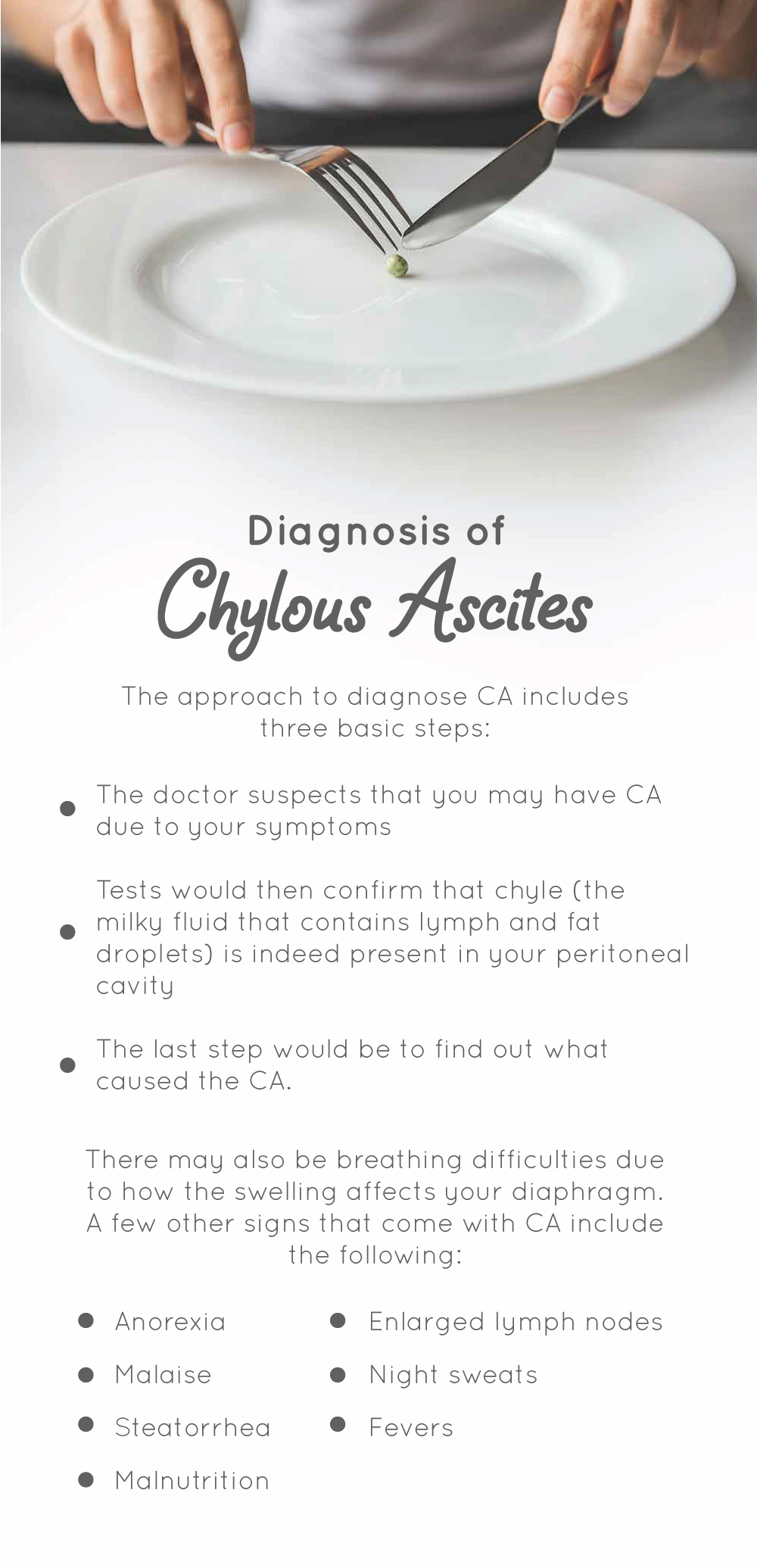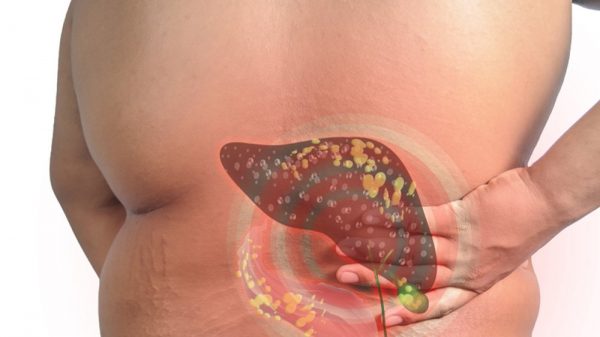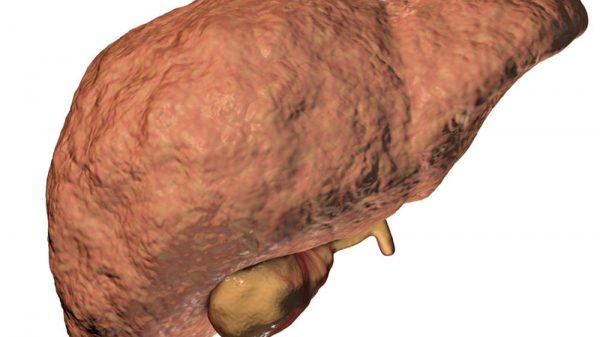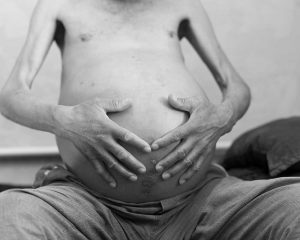Chylous ascites (CA) refers to the buildup of fluid rich in triglyceride in the peritoneal (abdominal) cavity. This fluid is usually milk-like. The color and components of the ascitic fluid are due to intestinal lymph that is present in the cavity. The condition can either be primary or secondary. If the CA is primary, it is most likely due to lymphatic dysplasia. But if it is a secondary disorder, then it is likely due to trauma, neoplasia, inflammation, or complications of abdominal surgery. Generally speaking, anything that makes lymph to leak or that obstructs lymph vessels can cause CA. This article focuses on the causes, diagnosis, and treatment of CA.
The definite diagnosis of CA is when a milky ascitic fluid is present in the peritoneal cavity with more than 200 mg/dL triglyceride content. If you had cirrhosis before the diagnosis of CA, then that is most likely the cause. But if you didn’t have cirrhosis, you may need proper screening to rule out cancer. Many other health issues aside from cirrhosis can cause CA. Once you know the underlying health issue, your doctor(s) your therapy to deal with it. However, you will need some form of dietary support that includes a high-protein, low-fat diet with medium-chain triglyceride (MCT) supplements. You may need surgery if the case is resistant to dietary and medical treatments. This is, however, quite rare.
Diagnosis of Chylous Ascites
The approach to diagnose CA includes three basic steps:
- The doctor suspects that you may have CA due to your symptoms
- Tests would then confirm that chyle (the milky fluid that contains lymph and fat droplets) is indeed present in your peritoneal cavity
- The last step would be to find out what caused the CA.
To get this done, your doctor will take your medical history by asking you a series of questions. He or she will then carry out a physical exam (check your body for signs). And then, you will go for a diagnostic paracentesis.
Paracentesis means that a needle would be used to draw out the ascitic fluid. The fluid would then be taken to the lab to be thoroughly examined. This is very vital for the accurate diagnosis of ascites.
Before the doctor can suspect CA, a few clinical findings must be present. One of them is the gradual swelling of your belly with no pain.
If you have CA, your belly would swell gradually in a matter of weeks or months. How fast the swelling (distention) is will depend on the underlying cause. While most people would experience no pain, about 14 percent of people with CA would experience nonspecific pain.
However, if you have had a thoracic or abdominal surgery, the swelling may occur suddenly. But then, swelling of the abdomen is all there is to CA diagnosis.
You may also have some weight gain because your abdominal girth would increase. On the other hand, the underlying cause may lead to considerable weight loss.
There may also be breathing difficulties due to how the swelling affects your diaphragm. A few other signs that come with CA include the following:
- Anorexia
- Malaise
- Steatorrhea
- Malnutrition
- Enlarged lymph nodes
- Night sweats
- Fevers
When these signs are present, you would need to do a diagnostic paracentesis to confirm the presence of chyle in your abdominal cavity. This is the most vital diagnostic tool for the evaluation and management of ascites.
What Options Are Available For Treatment?
There are quite a few treatment regimens available for treating CA. They include diet, medication, and surgery. However, the most effective treatment, in the long run, is the one that takes care of the underlying health issue.
Most times, when you take care of the underlying issue, the CA would also resolve. This is true most especially if the underlying cause is an infection, inflammation, or a hemodynamic condition. One these are properly treated, the ascites, as well as accompanying symptoms will resolve.
Furthermore, treating CA may also include a therapy that targets decreasing the flow of chyle. The theory behind this is that when you do this, the chyle leakage would close by itself. But then, there is no exact way to monitor how you are responding to this therapy.
It is quite reasonable to follow a specific diet plan if you have CA. This is more vital if there is no known cause. You may also benefit from nutritional therapy if you don’t get better after you have treated the underlying cause.
The different types of nutritional therapy include the following:
- Bowel rest
- Dietary changes
- Enteral feedings
- Total parenteral nutrition (TPN)
The goal of these therapies is to slow down chyle production. They also help to replace electrolytes and fluid, as well as improve or maintain nutrition status as occasion demands.
If you would make dietary changes, you should eat a low-fat, high-protein diet. You should also take MCT supplements.
Unlike other forms of triglycerides, your body absorbs MCTs directly without having to convert them into chylomicrons. For this reason, eating low-fat with MCT supplements can reduce chyle production, as well as its flow.
However, if you have advanced cirrhosis, you should avoid MCT oil. This may cause as it may cause narcosis or coma. In such a case, your dietary changes should include low-sodium eating with the use of diuretics.
If you don’t get better with dietary changes, then you can try having bowel rest. This would reduce your lymph flow. Then, you can leverage on that and go for the option of TPN. This can relieve your symptoms, as well as rapidly close up any fistula.
Other Treatment Regimens
Other treatment regimens for CA are as follows:
- Drugs, such as octreotide and somatostatin to inhibit chyle production
- Abdominal paracentesis to drain the ascitic fluid
- Angiography
- Surgical intervention
Chylous ascites is quite uncommon. Your doctor can only confirm the diagnosis of CA after paracentesis. But then, it can be treated by taking care of the underlying cause. This usually resolves the CA, but if it does not, other treatment options like nutritional therapy and a host of others could be of help.
























